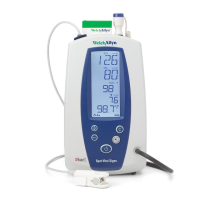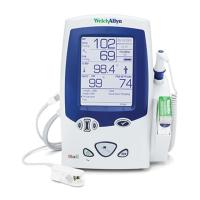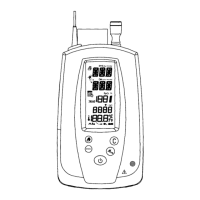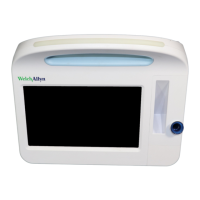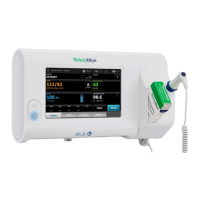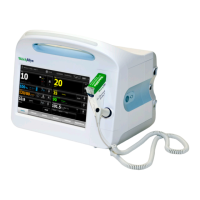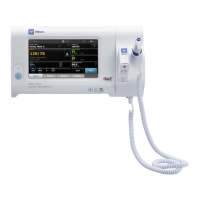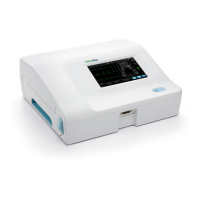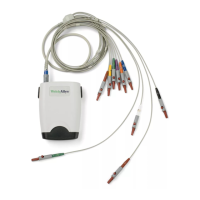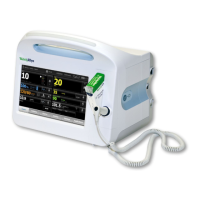
Do you have a question about the Welch Allyn Connex Vital Signs Monitor 6000 Series and is the answer not in the manual?
| Brand | Welch Allyn |
|---|---|
| Model | Connex Vital Signs Monitor 6000 Series |
| Category | Medical Equipment |
| Battery Life | Up to 8 hours |
| Compatibility | Compatible with EMR systems |
| NIBP Technology | Oscillometric |
| Vital Signs Measured | Blood pressure, pulse rate, temperature, SpO2, respiration rate |
| Display | Color touchscreen |
| Connectivity | Wired Ethernet, Wireless |
| Power Source | AC power, rechargeable battery |
| Weight | Approximately 6.4 lbs (2.9 kg) |
| NIBP Measurement Range - Neonatal | 40-120 mmHg (systolic), 20-80 mmHg (diastolic) |
| Pulse Rate Range - Adult | 30-200 bpm |
| Pulse Rate Range - Pediatric | 30-200 bpm |
| Pulse Rate Range - Neonatal | 30-200 bpm |
| Temperature Range - Oral | 32.0 to 42.9 °C |
| Temperature Range - Axillary | 32.0 to 42.0 °C |
| SpO2 Range | 1-100% |
| SpO2 Compatibility | Compatible with select Welch Allyn SpO2 sensors |
Explains warning and caution symbols used in the manual.
Describes symbols related to power states and AC power connection.
Details symbols for USB, Ethernet, and wireless signal strength.
Covers symbols for CO2, manufacturer, reorder number, and RoHS markings.
Lists critical warnings about electrical safety, fire hazards, and measurement accuracy.
Provides guidelines for accessory use, service personnel, and general device handling.
Explains ESD risks and precautions for handling sensitive electronic components.
Defines the manual's purpose for preventive maintenance and corrective service.
Outlines available support services like telephone support and service agreements.
Specifies periodic maintenance schedules for device components.
Details the standard and gold licensed editions of the service tool.
Identifies controls, indicators, and connectors on the front of the device.
Identifies controls, indicators, and connectors on the back and bottom of the device.
Provides step-by-step instructions to access the device's service screens.
Explains how to restore factory default settings and manage device configuration.
Describes how to view and save error and event logs.
Outlines the steps for performing the power-on self-test (POST).
Provides tables for diagnosing and resolving common device issues by symptom.
Lists technical alarm messages and their corresponding causes and solutions.
Lists and explains troubleshooting steps for NIBP-related messages.
Covers troubleshooting for SpO2 and SpHb parameter messages.
Provides troubleshooting steps for ECG module-related messages.
Provides disassembly instructions for devices manufactured before 12/2017.
Provides disassembly instructions for devices manufactured after 12/2017.
Lists all necessary tools and equipment for disassembly and repair.
Details the procedures for safely powering down the device before disassembly.
Provides steps for safely removing the device's battery.
Guides the user through removing the rear housing of the device.
Covers disassembly procedures for the device's main chassis.
Provides steps for removing the device's main board.
Outlines tests to confirm device operation and diagnose malfunctions.
Explains the service tool's editions and requirements for calibration.
Details procedures for NIBP leak, overpressure, and accuracy checks.
Outlines tests for SpO2, SpHb, heart rate, and RRa parameters.
Details functional testing for the ECG module.
Outlines test for ground continuity from EP stud to IEC power connector.
Details test for leakage current from EP stud to mains.
Guides on installing internal device options, requiring disassembly.
Details the process for updating device firmware using the service tool.
Explains how to activate licensed features using authorization codes.
Lists parts and service kits for the rear housing (2nd edition compliant).
Lists parts and service kits for the bottom housing (2nd edition).
Lists parts for front housing and midsection components.
Lists various miscellaneous parts and fasteners.
Lists service tools, software, and license keys.
Provides guidelines for decontaminating and cleaning the monitor before return.
Describes how to find and interpret the monitor's serial number and model label.
Lists the default settings for general alarms and NIBP parameters.
Lists tools and equipment for basic and full functional verification.
Provides torque specifications for screws and fasteners.
Shows system interconnectivity for 6-hole and 11-hole USB cable separators.

